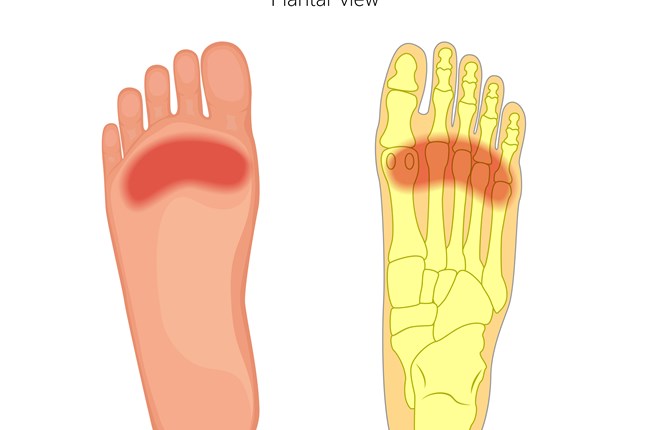What are the different causes of Metatarsalgia?
Capsulitis/ Synovitis-
Synovitis or Capsulitis is an inflammation of the joint and is usually accompanied by an increased production of synovial fluid that can cause the joint to swell.
Stress Fracture-
When excessive stress is placed upon the ball of the foot, a hairline break (fracture) of a long metatarsal bone may occur. This occurs most frequently to the second, third, or fourth metatarsal but can occur in any bone. Stress fractures can occur during sports activities, in overweight individuals, or in those with weakened bones such as osteoporosis.
Plantar Plate Injury-
A plantar plate injury refers to damage to the strong supporting ligament of a toe, located on ball of foot. The plantar plate is not an ordinary ligament as it’s a thick structure that provides significant stability to the toe. Most commonly the 2nd toe is involved, but any toe can be damaged. Plantar plate injuries can be acute or chronic.
Intermetatarsal Bursitis-
A bursa is a sac like structure filled with fluid, which lessnes the friction between ligaments, bones and tendons. Bursae are found near major joints in the body especially those that are used repeatedly. There are many bursae found between the metatarsal bones in the intermetatarsal spaces. Repetitive use of joints can develop into bursitis when the bursa is irritated and inflamed.
Neuroma-
A neuroma is the swelling of nerve that is a result of a compression or trauma. They are a swelling within the nerve that may result in permanent nerve damage. The most common site for a neuroma is on the ball of the foot. A small nerve passes between the spaces of the metatarsals. At the base of the toes, the nerve splits forming a "Y" and enters the toes. It is in this area the nerve gets pinched and swells, forming the neuroma. Burning pain, tingling, and numbness in one or two of the toes is a common symptom.
How can I reduce the pain?
A a full clinical examination and patient history can allow for a diagnosis. Once a diagnosis is made a treatment plan can be carried out. Various forms of scanning methods including X-ray, Ultrasound and MRI can be helpful in making a diagnosis and creating a treatment plan.
To reduce the pain short term:
- Wear good fitting suitable shoes with a thick sole at the forefoot - avoid high heels
- Use protective pads to cushion the affected area
- Rest, Ice and Elevate the foot
Ultimately, you need to see a podiatrist for a diagnosis to treat the pain.
How can Firefly Foot & Ankle Clinics help?
- We can offer advice on suitable footwear
- We can prescribe suitable exercise
- Where suitable we can prescribe custom made foot orthotics with deflective padding.
With the correct attention the contributing factors can be treated reducing pain and discomfort. If the problem is not treated the problem will continue to get worse resulting in ruption and toe deformity. If the condition persists surgery may be advisable.


